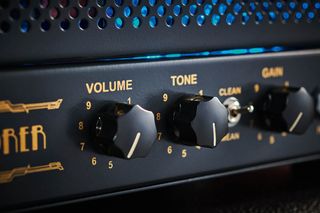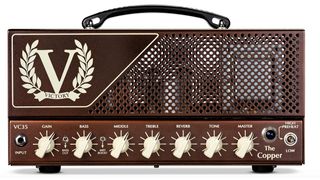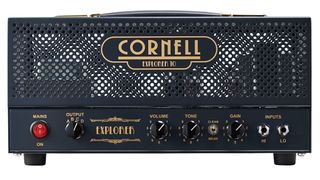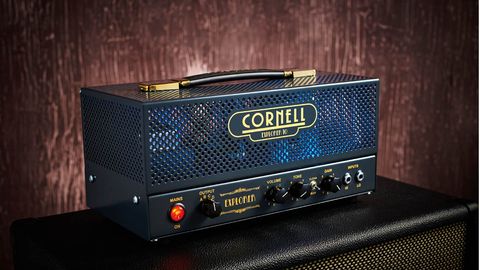What is it?
Denis Cornell is one of the most revered names in British guitar amplification. He was among those responsible for Sound City amplifiers and the Fuzz Face, back when he was making his bones at Arbiter.
He counts the likes of Eric Clapton and Noel Gallagher as his fans, and anyone who is familiar with his work can attest to the super-tough build quality and attention to detail. His latest, the Explorer 10, is a lunchbox-style class A valve amplifier that's housed in a typically rugged grey steel case, with perforated cover and smart gold handle trims.
It's a stylish little amp, and reassuringly heavy, too, with over-sized mains and output transformers under the hood. The electronics are hand-soldered onto a substantial circuit board, 4.8mm thick, that's arranged with printed tracks with turret and eyelet-style wiring – much like you might see in 1950s American amplifiers.
You'll find the base for the Explorer's sole 6L6 power valve housed on the main board, with the two 12 preamp valve bases mounted on the chassis with hand-wired links. As you might expect by now, the components are of the highest order, and audio geeks will be sent to their happy place upon witnessing the primo carbon comp resistors and flawless wiring.
We were struck by how quiet it was. Even when throttled, there was no hum, no hiss. This will record impeccably
The Explorer 10's setup is simple. It has a single-channel preamp with volume, gain and tone rotary controls. There’s a Clean/Mean switch that adds a respectable mid-boost, and a four-way attenuator switch to control the Explorer 10’s output power from 10 watts down to a measly 1/8 watt.
On the rear of the amp you'll find a pair of speaker outputs and an impedance switch with a choice of four- or eight-ohm loads, so you won't be lacking in cabinet options.
Upon switching the amp on you are greeted with four blue LEDs lighting up the preamp valves. There is no standby; a smart thermistor solution delays the full current en route to the mains transformer until said thermistor has warmed up.
Performance and verdict
The Explorer has a traditional single-ended output stage that is 100 per cent class A. In practice, this means the sole power amp is doing all of the amplifying all of the time. Of course, this is less efficient in a power sense – not to mention hard on the valve – but as with many things tone, inefficiency in a power sense can reap untold rewards with tone.
We can argue all night about this audio-power voodoo but there's no denying the results that countless guitarists have got from running low-wattage, single-ended valve amplifiers in the studio.
Pairing the Explorer 10 with a 1x12 cabinet, loaded with a Celestion Creamback, a Fender Strat with Seymour Duncan Alnico Pro pickups, and a ’72 Les Paul Custom with the original embossed humbucking pickups, we were struck by how quiet it was. Even when throttled, there was no hum, no hiss. This will record impeccably.

Although the Explorer 10 is a simple amplifier, there is plenty of variety on offer here. There's no shortage of brightness, but none of those ice-pick tones to set your teeth – and playing – on edge. Whether you are noodling some Montgomery lines on the LP's neck pickup or playing sharp, compressed country on the Strat, the Explorer's cleans are incredibly musical.
Dial in a little breakup and we're in Fender Tweed territory, albeit with a seasoning of Vox chime. The Clean/Mean switch is an excellent tool for fattening up your singlecoil tones, and when you crank the gain on the Explorer it just keeps coming.

• Victory VC35 The Copper
Victory's VC35 The Copper has an incredible tone and response, and surely would gave many high-end boutique amps a run for their money.
As for power, the 10-watts is deceptively loud, while the 1/8-watt setting will keep you on the next-door neighbour's Christmas card list.
The Explorer might not have all the connectivity bells and whistles of some other modern amplifiers. It might not have speaker emulation or other mod cons. But what it does have is super-high performance, a low-noise operation that makes it a superb studio amplifier.
Put a mic in front of it and go the old-fashioned way. Embrace the analogue. And sure it might be expensive but your outlay will be handsomely rewarded. After all, it's tones like this that all the digital amps want to copy.
MusicRadar verdict: A small, deceptively versatile tone monster that makes a great recording tool, the Explorer 10 is an exceptional amplifier.
Hands-on demos
Guitarist
Specifications

- PRICE: £899
- ORIGIN: UK
- TYPE: Valve preamp, power amp
- OUTPUT: 10W RMS, switchable to 2, 1/4 and 1/8W
- VALVES: 2x 12AX7, 1x 6L6GC
- DIMENSIONS: 165 (h) x 350 (w) x 180 (d)
- WEIGHT (kg/lb): 7/15
- CABINET: Pressed steel
- CHANNELS: 1
- CONTROLS: Gain, tone, volume, Clean/Mean switch, attenuator switch
- FOOTSWITCH: None
- ADDITIONAL FEATURES: 4-way attenuator switch reduces output from 10W to 2, 1/4 or 1/8W
- OPTIONS: None
- RANGE OPTIONS: None
- CONTACT: Cornell Amplification



